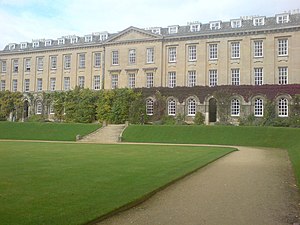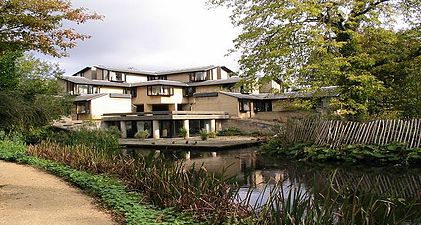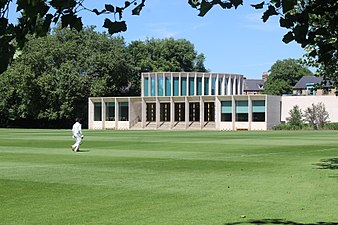Worcester College, Oxford
| Worcester College Latin: Collegium Vigorniense
| |||||||||||
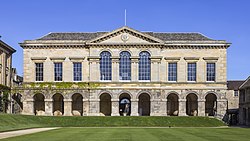 East side of Main Quad | |||||||||||
|---|---|---|---|---|---|---|---|---|---|---|---|
 | |||||||||||
| Provost: | David Isaac | ||||||||||
| Website: | www.worc.ox.ac.uk | ||||||||||
| |||||||||||
| Location | |||||||||||
| Grid reference: | SP50900650 | ||||||||||
| Location: | 51°45’18"N, 1°15’49"W | ||||||||||
Worcester College is one of the constituent colleges of the University of Oxford. The college was founded in 1714 by the benefaction of Sir Thomas Cookes, 2nd Baronet (1648–1701) of Norgrove, Worcestershire, whose coat of arms was adopted by the college.[1] Its predecessor, Gloucester College, had been an institution of learning on the same site since the late 13th century until the Dissolution of the Monasteries in 1539. Founded as a men's college, Worcester has been coeducational since 1979.[2] The provost is David Isaac, CBE who took office on 1 July 2021[3]
Buildings and grounds

The buildings are diverse, especially in the main quadrangle: looking down into the main quadrangle from the entrance through the main building, to the right is an imposing eighteenth century building in the neo-classical style; and to the left a row of mediæval buildings known as "the cottages", which are among the oldest residential buildings in Oxford. These cottages are the most substantial surviving part of Gloucester College, Worcester's predecessor on the same site: this was a college for Benedictine monks, founded in 1283 and dissolved with the Dissolution of the Monasteries in about 1539.
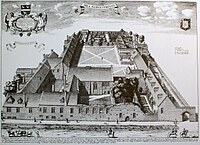
After a lapse of 20 years, the buildings of the old Gloucester College were used in the foundation of an academic hall, Gloucester Hall, in around 1560. The penultimate principal, Benjamin Woodroffe, attempted to establish there a 'Greek College' for Greek Orthodox students to come to Oxford, part of a scheme to make ecumenical links with the Church of England.[4] This was a going concern from 1699 to 1705, although only 15 Greeks are recorded as members.
In 1714, thanks to a fortunate benefaction from a Worcestershire baronet, Sir Thomas Cookes, Gloucester Hall was transformed into Worcester College. Even then, there were only sufficient funds to rebuild the Chapel, Hall and Library and the north side of the Front Quad, known as the Terrace. The designs were by George Clarke, who had consulted Nicholas Hawksmoor.
In 1736, Clarke generously left to the college his great collection of books and manuscripts. These included the papers of his father William Clarke]] (which are of crucial importance for the study of the history of the period of the Commonwealth and Protectorate) and a large proportion of the surviving drawings of Inigo Jones.
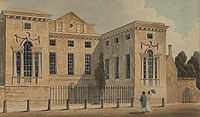
Owing to lack of funds, Worcester's eighteenth-century building programme proceeded by fits and starts. The west end of the Terrace and the Provost's Lodgings were added in 1773–1776 (architect: Henry Keene). The mediæval cottages were to have been replaced by a further classical range, but survived because money for this purpose was never available; the Hall and Chapel, by James Wyatt, were not completed until the 1770s.[5]
The Chapel
The College Chapel was built in the 18th century. George Clarke, Henry Keene and James Wyatt were responsible for different stages of its lengthy construction (1720–1791), owing to shortage of funds. The interior columns and pilasters, the dome and the delicate foliage plastering are all Wyatt's work. His classical interior was insufficiently emphatic for the tastes of militant Victorian churchmen, and between 1864 and 1866 the chapel was redecorated by William Burges. It is highly unusual and decorative; being predominantly pink, the pews are decorated with carved animals, including kangaroos and whales, and the walls are riotously colourful, and include frescoes of dodos and peacocks. Its stained glass windows were to have been designed by John Everett Millais, but Burges rejected his designs and entrusted the work to Henry Holiday. Oscar Wilde said of the Chapel, "As a piece of simple decorative and beautiful art it is perfect, and the windows very artistic."

The Chapel Choirs
Worcester is unique among the Oxford colleges in that it has not one, but two chapel choirs of equal status, which share out the weekly services between them. There is a mixed-voice choir constituted of auditioned choral scholars and volunteers, which sings twice a week: weekly on Thursday and on alternating Sunday and Monday evenings. The Boys' Choir consists of trebles from Christ Church Cathedral School and alto, tenor and bass choral scholars. This choir also sings twice weekly; on Sunday and Tuesday evenings. These choirs are run on a day-to-day basis by Worcester's two Organ Scholars alongside the director of music.
The Hall
William Burges was commissioned to redecorate the Hall, but was forced to curtail his elaborate designs by a lack of funds. A reduced scheme was completed in 1877 but was substantially altered in the early-twentieth century, and in 1966 Wyatt's designs were restored using his original drawings (preserved in the College Library), under the direction of architect Emil Godfrey. The Hall was refurbished and redecorated in 2018.[6]
Modern buildings
In more recent years, several new residential blocks for undergraduates and graduates have been added, thanks in part to a series of generous benefactions. The latest of these include the Earl Building, Sainsbury Building (which won the Civic Trust Award in 1984), Linbury Building, Canal Building, Ruskin Lane Building (for undergraduates), the Franks Building (for graduates), and the Sultan Nazrin Shah Centre, which won numerous architectural awards and was shortlisted for the 2018 Stirling Prize.[7]
The Canal Building sits next to the north entrance to the college and, as the name suggests, beside the Oxford Canal. It houses 50 students in large en-suite single rooms. The accommodation is usually reserved for third and fourth year undergraduates.
The Gardens
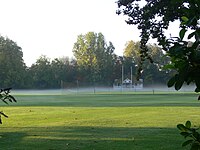
Although Worcester is near the centre of Oxford today, it was on the edge of the city in the eighteenth century. This has proved a benefit in the long run, since it has allowed the college to retain very extensive gardens and contiguous playing fields (a total of 26 acres, including a lake).
The gardens have won numerous awards, including the Oxford in Bloom college award every time they have been entered for the competition. Extensive work on the gardens was carried out between 1817 and 1820, and they may have been laid out in the Picturesque style by Richard Greswell in 1827. They are now managed by head gardener Simon Bagnall and a team of seven gardeners.
Pictures
-
The main quadrangle and mediæval buildings
-
The 15th century gate of Gloucester College
-
The main building
-
North range of the Quad, the 18th century Terrace
-
Provost's Lodgings, added to the North range
-
The cottages from the Nuffield lawn
-
Lake
-
Sainsbury Building (which won the Civic Trust Award in 1984)
-
Sultan Nazrin Shah Centre
Outside links
| ("Wikimedia Commons" has material about Worcester College, Oxford) |
References
- ↑ Burke's General Armory
- ↑ Communication from Emma Goodrum, college archivist
- ↑ "Welcome to our Provost David Isaac CBE". 1 July 2021. https://www.worc.ox.ac.uk/about/news/welcome-our-provost-david-isaac-cbe.
- ↑ Tappe, E. D. (1954). "The Greek College at Oxford, 1699–1705". Oxoniensia XIX: pp. 92–111. http://oxoniensia.org/volumes/1954/tappe.pdf.
- ↑ "History of the College". https://www.worc.ox.ac.uk/about/history-college.
- ↑ Goodrum, Emma (2018-04-20). "The Many Lives of Worcester College Hall" (in en). https://worcestercollegelibrary.wordpress.com/2018/04/20/the-many-lives-of-worcester-college-hall/.
- ↑ "The Sultan Nazrin Shah Centre". https://www.architecture.com/awards-and-competitions-landing-page/awards/riba-regional-awards/riba-south-award-winners/2018/the-sultan-nazrin-shah-centre.
- Nikolaus Pevsner: The Buildings of England: Oxfordshire, 1974 Penguin Books ISBN 978-0-300-09639-2
| Colleges of the University of Oxford | |
|---|---|
| Colleges:
All Souls • Balliol • Brasenose • Christ Church • Corpus Christi • Exeter • Green Templeton • Harris Manchester • Hertford • Jesus • Keble • Kellogg • Lady Margaret Hall • Linacre • Lincoln • Magdalen • Mansfield • Merton • New College • Nuffield • Oriel • Pembroke • The Queen's • Reuben • St Anne's • St Antony's • St Catherine's • St Cross • St Edmund Hall • St Hilda's • St Hugh's • St John's • St Peter's • Somerville • Trinity • University • Wadham • Wolfson • Worcester |
 |
| Permanent private halls:
Blackfriars • Campion Hall • Regent's Park College • St Benet's Hall • St Stephen's House • Wycliffe Hall | |



